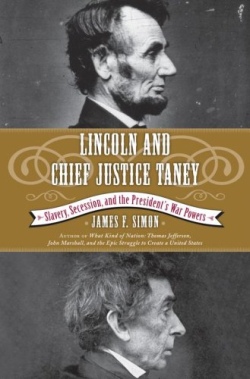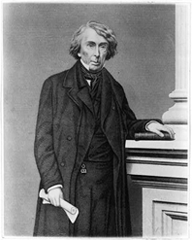Trying not to judge Chief Justice Taney History: The 'shrine' home of Taney, who has a thorny legacy because of Dred Scott, will be presented more impartially.
By Jeff Barker, Sun Staff, November 6, 2003
FREDERICK -- Nowhere is Maryland's ambivalence toward Roger Brooke Taney more evident than in this city, his adopted home.
Taney, the second- longest-serving chief justice of the U.S. Supreme Court, had a house here that now bears a plaque proclaiming it "a national shrine."
But Taney (pronounced TAW-nee) is best known for writing the 1857 Dred Scott decision holding that black Americans were not citizens, so "there's a lot of animosity about the house," says Dick Wettrich, who lives next door.
The difficulty in handling Taney's legacy is apparent as the Frederick County Historical Society prepares exhibits for the house and slave quarters he owned here from 1815 to 1823. The society acquired the buildings this year and is revisiting the manner in which they are presented to the public.
The society is planning a less reverential, more impartial approach -- one that doesn't judge whether Taney was a hero, villain or something in between.
"Taney was an enigmatic character," says Mark Hudson, the society's executive director. "We want to be as truthful and forthright as possible."
For 35 years, the house was owned by a foundation whose president, former Alderman H. Thomas Summers, calls Taney "a great man."
"He swore in seven presidents, including Abraham Lincoln," Summers says. "Dred Scott was a bad decision, but he was backed by other members of the court. Everybody makes mistakes during their lifetime."
The foundation donated the house to the historical society in June, mostly because of difficulty maintaining it.
The house sits in an old section of downtown Frederick where many of the residents today are black. The three-story brick home -- featuring many portraits of the long-haired, lanky-looking chief justice -- is connected by a breezeway to a slave quarters in the back.
Visitors to the home have long been greeted by the marble plaque declaring the structure a shrine, but it is probably going to be removed as part of the "reinterpreting" process, Hudson said. "The connotation of a shrine is that this is a great person and I don't necessarily challenge that, but our interpretative approach is going to be more objective," he said.
Also being removed is a bust of Taney -- a copy of a statue at Frederick City Hall -- that sits in a parlor room. The bust wouldn't have been there when Taney occupied the house, and the society says it wants all of the furnishings to be as authentic as possible.
The society doesn't know what to do with a large painting of Taney swearing in Lincoln. The painting has long hung in the house but it includes notables of the time who either weren't at the swearing-in, or weren't in the spots they are depicted in. "It doesn't accurately reflect history. It's stylized," Hudson said. "But it's been here a long time."
The society plans to close the house for several months beginning in mid-December while it makes the changes. It is informally soliciting comments from the neighborhood on what would be suitable for display.
In the 1857 decision, Taney said that Scott, a longtime slave suing for his freedom, was not a citizen and that no slave -- nor their free descendants -- had standing to sue in the federal courts. He based his ruling on an interpretation of the Constitution and Declaration of Independence. Of the latter document, he wrote: "It is too clear for dispute that the enslaved African race were not intended to be included, and formed no part of the people who framed and adopted this declaration."
But analyzing Taney, who was born in Calvert County but made Frederick his home, is no simple task.
In 1819, he successfully defended a Methodist minister from Pennsylvania accused of inciting slaves to riot. In his argument, Taney called slavery "a blot on our national character" left over from Colonial times.
Taney, who also served as U.S. attorney general and treasury secretary, "was known for his astute and acute legal mind," said Maryland Archivist Edward C. Papenfuse. "Do I believe he was a racist at heart? Yes. He was a strong believer in slavery. Was he a creature of his time? Yes. Should we ignore his historical contributions? No."
One of the Taney statues sits on the grounds of the State House, not far from one of Thurgood Marshall, the court's first African-American justice. There are also statues of both men in Baltimore.
In Frederick, an outdated, barracks-style public housing complex in an area known for crime bears Taney's name.
Willie Mahone, a black Frederick attorney, said he tried years ago to get the name changed -- he wanted it named after Marshall -- but authorities resisted.
Mahone keeps a copy of the Dred Scott decision in his desk -- "as a reminder," he said. When asked to pose for a newspaper photograph years ago, he chose to stand in front of Taney's statue at City Hall "because I wanted to imagine him turning over in his grave."
He applauded the historical society "for saying they're not going to do a governmental endorsement of the concept that he's a great man. It's proper to let the public make its own determination."
Copyright © 2003, The Baltimore Sun








